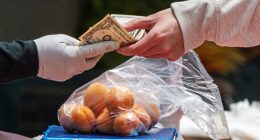
The popularity of Juul and its high-nicotine pods is driving up nicotine levels across the vaping industry in what Stanford researchers are calling a “nicotine arms race,” according to a new study. The findings back up suspicions that Juul’s competitors are watching the vaping giant closely to capitalize on the largely unregulated multi-billion-dollar e-cigarette market.
Researchers with Stanford Research Into the Impact of Tobacco Advertising investigated the nicotine levels that Juul imitators advertised. They looked at pods compatible with Juul devices or Juul-like knockoffs, as well as e-juice bottles for refillable pods and vapes. Their study, published Wednesday in the journal Tobacco Control and first covered by CNN, reports that before Juul made it big, most vape juice ranged from 1 to 2 percent nicotine, with three percent marketed to heavy smokers. But these days, products are advertising high concentrations of nicotine across the board, often in kid-friendly flavors and at prices lower than Juul’s.
Since Juul entered the picture in 2015, the company’s become wildly successful — overtaking competitors like the Vuse line of vapes to dominate more than three-quarters of the market. The past few years have also seen a rise in the number of kids in high school and middle school who are vaping, which reached a record 3.6 million this year. “We started to realize that Juul’s success had led to a fundamental change in the e-cigarette marketplace,” Robert Jackler, a professor at Stanford and senior on the study, told The Verge. “And many other companies started to emulate Juul in several important ways.”
Jackler and Divya Ramamurthi, also at Stanford, set out to to investigate how exactly Juul’s competitors were trying to copy the vaping giant. Some companies imitated Juul’s discreet design. But others also replicated what was inside that little device: Juul’s patented nicotine salts — a type of nicotine that feels more like a cigarette when inhaled. That’s different from previous generations of vapes that use freebase nicotine — a harsher form of nicotine that’s more common in cigars. Nicotine salts are easier to inhale, so e-juice manufacturers like Juul can afford to up the nicotine dose without making the vaping experience unpleasant.
The researchers shopped and searched online for pods that advertised themselves as “Juul compatible”, as well as high nicotine-dose e-liquids, and pod-based vapes similar to Juul. They found 14 companies selling nicotine salts pods compatible with a Juul, many of which were cheaper than actual Juul products. All came in kid-friendly sweet flavors, and all contained high nicotine doses of 5 percent nicotine or more by volume. (The confusing thing about Juul is that it reports the nicotine dose for the majority of its US pods as 5 percent nicotine by weight, which makes it hard to compare it to other products.)
They also turned up 39 devices similar to Juuls — including refillable, non-refillable, and disposable vapes. Again, all the pre-filled pods for those vapes came in kid-friendly flavors, contained more vape juice than Juul pods, and advertised equivalent or higher levels of nicotine, as well. As for the bottles, Jackler and Ramamurthi found 71 brands offering bottles of nicotine salt e-liquids with high concentrations of nicotine.
Gideon St. Helen, a tobacco researcher at the University of California, San Francisco, says that for low-powered devices like Juul, you need a higher nicotine vape juice to deliver enough nicotine in the aerosol. Lower nicotine liquids, by contrast, are typically used in the high-powered mods that produce a big plume, he says in an email to The Verge. “The important question is, which of these scenarios is less harmful?” St. Helen says. “My bet is, a low power, high nicotine e-cigarette is less harmful to users than a high power, low nicotine e-cigarette.”
Jackler agrees that Juuls may be somewhat less harmful than higher powered vapes. “These larger devices with big coils and high power actually produce more toxic substances,” he says. (Still, he clarifies, “There’s nothing natural about breathing in and out propylene glycol, and glycerine, or flavorant chemicals.”) But the possibility that a kid could get into a bottle of sweet-flavored, high-nicotine vape juice is especially concerning to Jackler: nicotine is a poison, and toddlers like to stick things in their mouths. Despite stern warnings from the Food and Drug Administration that vape juice should not look like food or candy, many of the bottles were brightly packaged and contained sweet flavors, the study says. “One teaspoon contains enough dose to kill 5 toddlers,” Jackler says.
For what it’s worth, Juul doesn’t seem to like the rise of Juul pretenders, either. After all, cheap knockoffs are bad for business and their proliferation could hurt the company’s image, which has already taken a major hit because of the device’s popularity with young people. “‘JUUL compatible’ products described by Dr. Jackler and his team appear to be illegally on the market because they were first marketed after August 2016,” Victoria Davis, a spokesperson for Juul, said in an emailed statement. That date’s significant, because any product that goes to market after August 2016 is supposed to get approval from the Food and Drug Administration before hitting shelves. “We believe any product illegally on the market should be removed immediately.”
To that end, Juul has been chasing down companies making counterfeit devices and pods, according to a recent news release. And in October, Juul filed a complaint with the United States International Trade Commission about companies that it claims are infringing on Juul’s patent. Davis also says that Juul wasn’t the first to market nicotine salts. RJ Reynolds Vapor Company, for example, was already selling the Vuse Solo at that point, a 4.8 percent nicotine salts product, according to company spokesperson Michael Shannon. But Jackler points out that back then those salts products were the exception — now, they’re becoming the rule. “The motivation of those who introduce products with high nicotine salts really was not well-established until after Juul was already clearly becoming a viral product,” he says.
There are a few public health fixes that Jackler and Ramamurthi propose. An urgent one is regulating high-volume, high-nicotine bottles of vape juice so that young kids can’t accidentally eat the contents. The team also suggests banning kid-friendly flavors altogether in vape juices that contain nicotine, and making high-dose products like Juul available only with a doctor’s prescription. “We have urgent need to put in a suite of effective policies,” says Jackler, “that stem the tide of these being picked up by young people.”
This article is from The Verge









